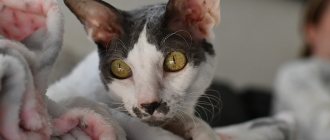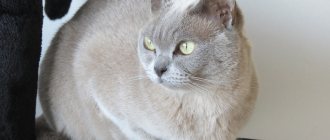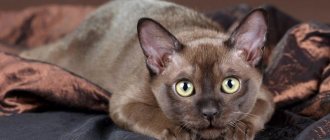Burmese cats are considered not only beautiful and elegant, but also have extraordinary thinking. Such a pet will become a real decoration of the house and the pride of the owners. They are original and intelligent, their short hair is always distinguished by original shades, and their large eyes are simply mesmerizing.
Experts distinguish several branches - American, Australian, European and Asian. They all differ from each other in shades, habits and some other features. Experts note that thanks to its appearance and independence, the Burmese will become a real home guard and the pride of the family.
History of the Burmese breed
The union of Burmese cats with people dates back to the times when representatives of this breed were considered sacred in their homeland. The homeland of Burmese cats is Burma (modern Myanmar), where the graceful animals were considered temples and were revered on a par with deities. According to legends, cats accompanied people during their transition to the kingdom of the dead. Keeping a cat in the house promised the owner prosperity and good luck.
The first Burmese were brought to San Francisco by Joseph K. Thompson in 1930. There were two of them: a male and a female, but the cat did not live very long, but the cat named Wong Mau was left alone and was included in the breeding program, the developers of which were Joseph K. Thompson, Billy Gerst, Virginia Cobb, as well as geneticist Clyde Keeler . The first mating was carried out with a Siamese cat Tai Mau, the second - with a brown kitten from the first litter. The babies of the third type were born and became the first representatives of the breed, which received the name Burmese.
In the mid-30s of the last century, the breed was recognized by the American Cat Fanciers Association (CFA) with the only color possible at that time - brown. However, in 1947, the breed was recalled due to the dishonesty of breeders who bred Burmese with representatives of Siamese cats. A year later, the first Burmese cats appeared in Great Britain and were recognized within 4 years. And in 1957, brown cats again received official status in the CFA.
Today there are two branches of the Burmese breed: American and European. Even crossing these two branches with each other is prohibited.
American Burmese are different from European ones
The photographs clearly show the differences between the American and European Burmese cats.
Burmese fur has a deep color
Varieties
After the American breeder Thompson introduced the beautiful Burmese to the world, the Europeans decided to take up the matter. They sought to improve the breed, providing the pet with lighter weight and refinement. Americans were not delighted with such innovations. This is what easily forms the basis for dividing the breed into two varieties.
Table - Differences between American Burmese and European Burmese
| Part of the body | American type | European type |
| Coat color | — Sable; - champagne; - platinum; - blue | - Chocolate; - brown; - blue; - lilac; - cream; - red; - blue tortoiseshell; - brown tortoiseshell; - lilac tortoiseshell; - chocolate turtle |
| Eyes | — Large, round; - surprised; - “childish” look | - Slightly inclined towards the tip of the nose; - the upper line of the eye is smooth, and the lower line is rounded; - look “from under your brows”, somewhat stern |
| Ears | - Medium size; - seem vertical, since they are somewhat closer than that of a European | - Low set; - longer; - slightly tilted forward |
| Muzzle | — Round; - full cheeks; - no flat areas | — Shape of a blunt short wedge; - wide cheekbones; - pronounced strong chin |
| Body type | — Compact, muscular; - heavy build; - strong, short limbs | — Elegant, sophisticated; - lighter frame; - thin, long limbs |
Description of the Burmese breed
Burmese are so unique that it is almost impossible to confuse them with other breeds. They outwardly resemble graceful pumas, but at the same time they are distinguished by their amiable character and playful disposition, which persists into adulthood.
Appearance: coat color and thickness, eye color, anatomical features
Despite the differences in the appearance of the American and European Burmese, the main features of their appearance are similar.
The Burmese cat is of medium size, muscular body, very harmoniously built. The back is straight, smoothly turning into a fairly long neck and a well-developed chest. The legs are quite thin, proportionate to the body, the hind legs are slightly longer than the front ones. The tail is of medium length, slightly tapering to a rounded tip.
The head is round in shape with large, widely set ears, rounded at the ends. The eyes are large, almost round, the iris can have shades from amber to yellow.
The Burmese's coat is short, satiny-silky, has virtually no undercoat, and lies tightly to the body. Always has a deep color.
It cannot be confused with any other breed
Colors
For the American Burmese, only 4 colors are recognized:
- sable (dark brown);
- champagne (chocolate);
- blue (bluish-gray);
- platinum (pale blue tone with lilac-pink coating).
The European Burmese has many more recognized colors:
- brown (warm dark brown);
- blue (bluish-gray with a pewter sheen);
- chocolate (from caramel to milk chocolate color);
- lilac (light gray with a pinkish tint);
- red (warm orange);
- cream (pastel cream);
- brown tortoiseshell (has black and red spots);
- chocolate tortoiseshell (milk chocolate coat has cream spots);
- blue tortoiseshell (bluish-gray coat with cream and light blue spots);
- lilac tortoiseshell (purple coat with light cream spots).
In both types of Burmese cats, color is temperature dependent. It changes depending on the ambient temperature: the colder it is, the darker the muzzle, back, tips of the paws and tail become.
The main differences in the appearance of American and European Burmese cats
In addition to color, there are several other features that make American and European Burmese different from each other.
- Eyes. In the American Burmese they are large and round, as if surprised, while in the European Burmese the upper line of the eye is almost straight, with a slight slope towards the nose, because of which the animal’s gaze seems stern, as if from under its brows.
- Ears. The American Burmese's ears are smaller, they are set higher and the distance between them is narrower than that of the European Burmese. At the same time, the ears of the European Burmese continue the line of the cheeks and have a slight tilt forward.
- Head. The European Burmese has a slightly more elongated muzzle, similar to a blunt wedge, while the American Burmese has a more rounded head shape and a slightly flattened muzzle.
- Torso. American women are more rounded and heavier in appearance, while European women are more graceful and sophisticated in appearance.
- Limbs. As in the case of the body, the European Burmese's paws are long and thin, while the American representative's paws are denser and have a rounded shape.
Despite their different appearances, they have similar characters
Traditional and modern American Burmese
American Burmese, in turn, are divided into two more types: modern and traditional. During exhibitions they are rated the same, but they differ in appearance. In the modern type, the transition from the forehead to the nose is more pronounced, the muzzle itself is shorter and wider compared to the traditional type. In addition, the eyes of the modern Burmese are more convex, which gives the muzzle an almost doll-like expression.
Character traits
The main quality of the Burmese, which makes it such a popular breed, is its extraordinary devotion to its owner. It’s not for nothing that this animal is called a cat-dog. However, they also get along well with dogs. In fact, these graceful creatures love people very much, tolerate loneliness extremely poorly and almost never show aggression towards people. This is a companion cat, keenly interested in everything that happens in the house. She will always be where people are. Does not tolerate loneliness well; in the event of a long absence of its owners, it becomes very bored.
It's impossible not to fall in love with them
At the same time, Burmese cats are affectionate and playful, remain active until old age and will never refuse the opportunity to run after a toy. They are inquisitive, tirelessly exploring the surrounding space, quickly reacting to changes in the environment. A passing midge will definitely attract the attention of a Burmese, as will a rolled out ball and a sunbeam running along the wall.
The oriental fluffy beauty will become a companion in the child’s childhood games, will patiently endure the baby’s pranks and will hardly be able to afford to let out her claws even once.
A friend of mine got a Burmese cat long before her daughter was born. The young mother, quite naturally, was worried about how the cat, who was the only object of love in the family before the baby’s appearance, and her growing daughter would get along with each other. In fact, for the first couple of weeks, Cassie (that’s the cat’s name) watched the newborn from afar, gradually reducing the distance to the baby’s crib. When, at about three months of age, the baby burst into tears, and her mother left the room at that moment, Cassie went in search of the owner and very demandingly called her to the girl. But that wasn’t even surprising for me. The grown-up baby, quite expectedly, wanted to constantly touch the cat. She crawled after her pet with amazing speed and periodically grabbed her by the tail, then by the paw. Cassie patiently endured all the squeezing, which was not always gentle, and never scratched the child. If the girl’s attention became too intrusive, Cassie simply left: she jumped on the closet or hid in the back room. Now the baby is five years old, and Cassie is already seven and it seems they have become just friends. When a girl comes with one of her parents after kindergarten, the cat certainly goes out into the corridor to meet them, but first she rubs herself against the child’s legs and purrs something joyfully in her cat language. And watching them play together is a real pleasure.
The Burmese cat is a reliable and loyal friend
Burmese get along well with other animals in the house; they will never be the first to show aggression, but if necessary, they can stand up for themselves. At the same time, the Burmese cat always occupies a leading position.
Burmese are well trained, easily assimilate the requirements of the owner, quickly understand where to sharpen, when and in what place to relieve their needs.
Tips for choosing a kitten
To purchase a Burmese kitten, be sure to contact the nursery!
This will be a kind of guarantee that the animal has a pedigree and the absence of various diseases.
Of course, you can purchase an animal both on the market and through online advertisements; fortunately, nowadays there are plenty of people willing to sell. And such a purchase will most likely help save the family budget. But in this case, you cannot be firmly confident either that the kitten belongs to the right breed, or that it does not have diseases that you will have to fight with for the rest of your life.
If you are finally ready to buy a Burmese kitten, decide on some points.
- Is this just a family friend or a potential participant in future exhibitions?
- Boy or girl?
- Baby's color.
If participation in exhibitions is not planned, then choose your pet according to your heart. It is “your” baby who can bring you a sea of joy and positivity.
There is also not much difference between boys and girls. Both are distinguished by cleanliness and equally love their owner. The only thing is: cats will have more weight, while the appearance of the cat will be more graceful.
The baby's color changes and is fully formed only at a later age!
If you have decided on all the issues, be sure to examine the animal and talk to the breeder. The kitten must have a clean and well-groomed appearance; the first worming and vaccination have usually already been carried out by this time. The breeder will clarify the baby’s nutritional issues and give the necessary recommendations.
Purchasing a Burmese kitten
When deciding to purchase a Burmese cat kitten, you need to understand that this must be a conscious and balanced choice. It is not recommended to purchase a Burmese kitten from someone else. If a potential owner wants to get a purebred kitten, then it must be purchased exclusively from a nursery. Only in this case can you purchase a healthy purebred kitten that can meet all the owner’s expectations.
Criterias of choice
When choosing a kitten, do not hesitate to ask the breeder about the character, nuances of keeping and the peculiarities of caring for the cat. You should also tell the seller about your expectations and goals. Usually, owners of trusted catteries are happy to select a kitten in accordance with the wishes of the potential owner.
- The baby should be active, playful and mobile.
- The kitten's fur is silky and shiny. Spots and medallions, as well as numerous white hairs in the color, are unacceptable. There may be faint stripes that disappear after six months. Over time, the baby's fur will acquire a darker shade.
- Ears, eyes, nose are clean.
At what age should you buy a kitten?
It is best to purchase kittens older than three months, since at this age the baby can be weaned from its mother and has already received the necessary vaccinations.
Other purchase details
There is no need to pick up a kitten directly from the exhibition; it is better to visit the nursery and see the conditions in which the kittens are kept and the behavior of the babies in their familiar environment.
If you purchase a baby for subsequent participation in exhibitions, the breeder will select a show-class kitten, but if you just need an affectionate and loyal friend, then when choosing, you can be guided solely by personal sympathies.
Burmese kittens are very inquisitive
How to choose a kitten
A Burmese kitten can be separated from its mother no earlier than three months from the moment of birth. During this period, the baby is ready for separation both physically and psychologically. When choosing a kitten from a nursery, you need to pay attention to its health. The kitten may have discharge from the eyes if they are clear in color. This is a regular tear fluid that cleanses the mucous membranes. You should be wary if it is yellow, in this case it is better to seek help from a veterinarian. Coat color develops before the first year. Sable color can be beige, with various shades of this color.
Purebred purebred animals can only be found in specialized nurseries. The bird market or ad sites are not the places where you can buy a real Burman. There is a high risk of acquiring a mestizo or a sick individual.
Kittens of the Burmese breed.
Who is the Burmese cat suitable for?
The Burmese breed is considered a versatile breed. Such pets take root well in all conditions if the family has children or other animals. Homebodies who will spend a lot of time with their pet can teach him simple tricks. You can walk with such a cat outside (just not during the frosty period). Allergy sufferers should not worry about animal hair; it does not provoke reactions.
If a person spends a lot of his time at work, it will be difficult for a cat, since they are considered sociable animals that need company and human attention. Being alone causes depression and stress.
How much does a Burmese cat cost?
You can buy a Burmese at a price from 15,000 to 35,000 rubles. The cost depends on the specific nursery, the pedigree of the animal, and its characteristics. If a kitten is purchased abroad, prices can vary from 30,000 to 50,000 rubles. Pet stores may offer lower prices, but it is more difficult to purchase a purebred purebred kitten here.
In the nursery you can choose ordinary Burmese or elite kittens. You can purchase disqualified kittens that have some flaws at a big discount. Individuals removed from breeding are also sold for a nominal fee.
Photo gallery: Burmese cat
These cats are incredibly beautiful
They don't like loneliness
Burmese are sociable, but unobtrusive
Get along well with other pets
Burma is a caring mother
The curiosity of cats of this breed knows no bounds.
TOP nicknames
What do you call the cheerful, restless kitten that appeared in your house? Take a close look at the tomboy. Perhaps the name will come on its own. If this does not happen, then consider the nicknames presented below.
A “girl” Burmese cat can be called:
- Alice;
- Bagheera;
- Darcy;
- Gressi;
- Josephine;
- Diana;
- Camila;
- Cecil;
- Josephine;
- Fifi.
If you have a “boy” Burmese cat, you can name him:
- Gray;
- Marquis;
- Sirius;
- Onyx;
- Juan;
- Williams;
- Scotty;
- Justin;
- Caesar.
Keeping a pet
Keeping Burmese cats is not difficult, but requires knowledge of some features.
Nutrition
The quality of Burmese wool directly depends on the quality of food
The Burmese cat is not particularly picky about food, but the owner needs to know that it plays an important role in maintaining the health and activity of the cat, and also directly affects the lifespan of the graceful pet.
Quantity and composition of food
It is possible to provide food for a Burmese cat with both natural food and ready-made dry or canned food of high quality, that is, super premium class.
When feeding ready-made dry food, you should strictly follow the instructions on the packaging, measuring the recommended amount of food using a scale.
If the owner prefers to use canned food, usually one jar (80–100 grams) contains one serving of food.
Breeders and experienced Burmese owners recommend the following food for this breed:
- Pro Plan;
- Hill's;
- Eukanuba;
- Bozita;
- Nutro Choice;
- Iams;
- Innova Evo.
Quality cat food
Natural nutrition requires more time for preparation, variety in the diet and additional vitamin supplements. The basis of the diet is necessarily raw dietary meat, served to the pet after freezing and subsequent scalding with boiling water. A cat consumes 80–100 grams of meat per day, this is 80% of the total amount of food for the day. Dietary types of meat include white poultry meat, rabbit meat, beef and veal, as well as offal of these same animals. It is possible to include exclusively sea fish in the diet and no more than once a week.
You need to give your pet fermented milk products, hard-boiled egg yolk (no more than 2 pieces per week), fresh vegetables and herbs. These products make up the remaining 20% of the total food, their total weight can be about 20 grams.
There should always be a sufficient amount of clean drinking water available to the animal.
How many times a day should you feed your pet?
An adult cat is usually fed twice a day; no additional feeding is required. If the animal has not eaten its portion within half an hour, the food is removed until the next meal. This is how the pet gets accustomed to the correct diet.
Kittens are usually fed at least four times a day until about sixteen weeks of age, then they are transferred to three meals a day, and by the age of one year the baby can already eat 2 times a day.
The role of a balanced diet in cat health
It must be remembered that diet directly affects the health and beauty of the cat. With a properly selected and balanced diet, the cat remains active, its fur shimmers beautifully. If the coat becomes dull (and in the Burmese this becomes noticeable quickly), then the diet should be reconsidered. You may need to consult a veterinarian and then select a different food or create a new diet.
Appearance care
Caring for a Burmese cat is not difficult, the main thing is to follow certain rules, then the beauty with oriental notes in her appearance will delight you with her beauty every day.
Brushing and bathing
The coat is short and close to the body and does not require special care. It is enough to comb your pet once a week using a special brush with small silicone spikes; twice a month you can comb it with a special comb for animals - a furminator with the smallest tooth size. During molting, increase the number of combings to 2-3 per week.
Burmese are bathed only when they become dirty or in preparation for an exhibition. Shampoos are used specifically designed for animals, with mink oil or cocoa butter.
High quality grooming for pets
Other beauty tips
Once every two weeks, the Burmese needs to cut its claws with special scissors, and the kitten must be accustomed to this procedure from an early age. You should also examine your pet’s ears once a week and, if necessary, clean them using special lotions or solutions.
If your cat's eyes are sour and it is not permanent, you can wipe the eyes with a decoction of chamomile or tea.
Buying the necessary things for a kitten
Before a Burmese kitten appears in the house, you need to prepare for its reception, purchase the necessary dishes for the baby (one bowl for food, the second for water), a tray where the baby will relieve his natural needs, toys and a scratching post.
Burmese cats are very active, and toys allow them to channel their energy in the right direction. All kinds of balls, balls with an elastic band, feathers on a stick, mice will be a success during games.
A scratching post for Burmese is a necessary accessory, as these cats love to scratch their claws. If your pet does not have a special place for this activity, she will designate it for herself, but the upholstered furniture will suffer greatly.
When choosing a tray, you should know that Burmese love to row behind them. Therefore, a tray with a grid will not suit them. For this breed, it is better to choose a high pot with a side or a covered house.
But Burmese cats do not have any special requirements for the type of filler; they are happy to use silica gel, bentonite or pressed sawdust.
Such a deep tray is quite suitable for a Burmese cat
Burmese people walking on the street
The Burmese cat does not need a special walk; it can quite easily not leave the apartment. But if the owners themselves want to walk the cat on the street, then they should accustom it to this from an early age. At the same time, walks can only be done in the warm season, since Burmese do not like frosts and drafts, and the temperature-dependent color will begin to darken when walked in sub-zero temperatures.
It is imperative to walk a Burmese cat on a harness, since the curiosity of this breed practically knows no bounds, and the pet can get lost while chasing an object that interests it.
Free range is not recommended for this breed
6.1. Cat's receptivity to training
Despite its well-deserved reputation as a freedom-loving and independent animal, the cat is perfectly trained, and from an early age. Suffice it to recall the story of a kitten who, being raised with puppies, urinated with his leg raised! It should be noted, however, that you can teach a cat only forms of behavior that are natural to it, strengthening them or, conversely, weakening them. And this is an entire art, in which only rare circus performers achieve success. Their method of training is to emphasize and reinforce the unique behavior of each of their animals, after which it remains to come up with a scene so that it looks most natural and impressive. Motivations for behavior are perhaps more important for a cat than for a dog: the animal must want to behave in a certain way. In experiments with Pavlov's dogs, treats were actively used, but they do not work with cats; attachment to the owner and a taste for play are much more effective motivations. The very use of the concept “motivation” serves as proof that neuroscientists rate feline intelligence very highly.
Recent advances in explaining the mechanisms of cat behavior have led to the unambiguous conclusion that the psychomotor development of animals, just like in humans, begins in the womb long before birth. The behavior of the mother is therefore of great importance for the future offspring and their learning abilities.
A group of British researchers also found that a cat’s sociability and the degree of its gullibility towards humans can be genetic and inherited on the paternal side. So far this is the only known influence of the father on the offspring, especially since he is not at all involved in raising them. The most favorable time for training and raising kittens is from their birth until they reach 6 months of age. Nevertheless, as they say, it is never too late to learn, and therefore it is quite possible to engage in the re-education of an adult animal, it all depends on the character of the cat and the pedagogical abilities of its owner.
Three factors determine a kitten's behavior:
- direct training, which occupies a central place in the formation of his character,
- the role of the mother, whose influence on his entire further development can hardly be overestimated,
- familiarization with other animals, as well as with people; the future adult life of the kitten will largely depend on how it passes.
We are talking about the emergence of connections between the kitten and the outside world and the development of behavioral patterns characteristic of felines. This process occurs very early in cats, especially compared to dogs, and plays a crucial role in both the normal development of the young animal and its mental health. The intensive training phase begins from the 2nd week after birth and ends by the 7th week, sometimes a little later. During this period, it is extremely important to take care of creating a “play environment” in the room where the kittens live, which is necessary, according to ethologists, that is, specialists in animal behavior, to create various sources of stimulation of children’s interest in the surrounding reality, and, consequently, development They have smarts.
Kittens interacting with each other and playing with each other are extremely important for their development before the age of 8 weeks. By the 3rd month, the animal’s attitude towards other friendly creatures (human, dog, rabbit, etc.) also develops. The nature of the cat’s relationship with its future owner and the strength of its attachment to him largely depend on how this adaptation to the surrounding world proceeded. To increase an animal’s sociability, you should introduce it to as many different people as possible at a very early age, literally in the first weeks of its life: let it play with them, sit in their arms, in this case you are guaranteed an animal with a light, open disposition . It will easily adapt to everyone and everything. Communication with one person, or maximum two, will turn the cat into a monogamous cat, unusually attached to the owner. You should not hesitate to accustom your cat to the proximity of other living creatures with whom she will subsequently have to live under the same roof, otherwise this will be much more difficult to do later. And first of all - to children, who in the eyes of a cat are completely special representatives of the human race. These unpredictable creatures are capable of making piercing sounds, and most importantly, they strive, taking advantage of the inattention of adults, to grab a cat peacefully passing by by the mustache, ears or tail. What can I say, small children sometimes cause a lot of trouble for cats. It is therefore very important to introduce them to each other as soon as possible, especially if the animal sees them infrequently, for example, when grandchildren come to visit their grandparents.
Grooming, bowel movements and feeding (in addition to mother's milk) are to some extent, of course, innate actions, but at the same time, all these skills are quickly instilled in the cubs by their mother. A one-month-old kitten can already eat the same food as its mother, while he imitates her behavior and acquires the same habits. The ability to drink fresh water, which is very different from milk, is also acquired at this age. If you don’t want to get picky and struggle with feeding, try to give your kitten a variety of food, both in taste and consistency (dry food, meat balls, etc.).
Breed defects
Burmese are distinguished by good health and have good immunity. However, a tendency to certain diseases is still present.
Common Breed Diseases
Among the most popular diseases for Burmese are the following:
- gingivitis (gum inflammation);
- deformation of the skull (congenital);
- increased lacrimation;
- labored breathing.
Regular visits to the veterinarian, timely vaccination and deworming will help you avoid health problems for your pet. As a preventive measure and to get rid of worms, the cat is given anthelmintic drugs at least once every six months and always two weeks before vaccination.
Once a year, the cat is given an antiviral vaccination and once a year a rabies vaccination. Before vaccination, a doctor's examination is required, since vaccination is carried out on a healthy animal.
Defects in appearance
Breed standards do not allow Burmese cats with the following defects to qualify:
- Broken or abnormal tail, medallions or spots.
- Blue eyes. Strabismus. Incorrect color of nose or paw pads.
- Malocclusion leading to severe overbite or underbite, which visually violates the profile described in the standard.
- Improper jaw formation, resulting in protruding, protruding teeth or a distorted face or jaw.
- Pronounced stripes along the body. Any color that differs from the acceptable ones.
Grooming
For the Burmese - a short-haired breed - it is enough to comb 1-2 times a week using a special brush; at the end of the procedure, it is better to smooth the coat with a piece of suede - this way you can give it a shiny look.
Kittens inherit the ability to groom their fur from their mother cat.
But you can help a baby separated from his mother a little by wiping the fur with a slightly damp cloth, paying special attention to the hind legs. There is no need to bathe the kitten; only in case of severe contamination or in order to get rid of fleas, bathing may be necessary
In this case, choose a shallow container, the kitten should stand firmly on its paws, the water should reach the neck, its temperature should be about 36-39°C.
Breeding the Burmese breed
Breeding Burmese cats requires certain knowledge.
Criteria for choosing a partner
When choosing a partner for a Burmese cat, it is necessary to carefully study the pedigrees of both animals in order to avoid the manifestation of genetic defects in the offspring. American and European Burmese cannot be crossed with each other.
- When choosing a partner for mating, you should choose a healthy and beautiful representative of the breed. One of the animals must already be untied, otherwise the planned mating may not work out.
- The partner must not have any congenital defects or diseases.
- Both animals must be vaccinated and dewormed 14 days before the intended mating.
- Cats and cats should have their claws trimmed to avoid injury during mating.
In addition, you should remember that the cat should not be washed before mating so that its smell does not disappear. Mating is carried out only on the territory of the cat. The cat is brought to him after the start of heat and left for several days.
Choosing a mate for a Burmese cat is not easy.
At what age should you give your pet for the first mating?
The Burmese cat is characterized by early puberty, the first signs of which can be noticed already at six months of age. At the same time, Burmese estruses are frequent and are accompanied by loud “singing.” The first mating of Burmese cats is allowed after the first or second heat, but not earlier than she is one year old.
How often can a cat give birth?
Burmese, like other felines, can give birth several times a year. However, frequent childbirth is harmful to the health of the animal, since the body does not have time to recover. Therefore, a cat taking part in breeding can give birth 3 times within two years.
Burmese cat is a very caring mother
If the mating is successful and pregnancy occurs, the Burmese will bear kittens for 62–72 days. Typically, a cat of this breed gives birth to 3 to 5 babies. Having become a mother, a Burmese woman shows her best parenting qualities. She is caring and gentle with the kittens, takes care of them touchingly and teaches them good manners, from visiting the litter box to interacting with people. Unlike other breeds of cats, the Burmese allows a person to examine their offspring and take the babies in their arms.
Origin history and interesting facts
The mysterious Burma, which is known throughout the world for its magnificent temples, is considered the homeland of this exotic beauty. It is here, within the walls of the temples, that the history of the Burmese cat breed begins. The monks loved and revered their silky pets with intelligent amber eyes. They believed that these unusual animals served as guides to the afterlife, so they pleased the cats in every possible way.
Yellow-eyed creatures were worth their weight in gold. Therefore, only royal families and rich nobles could have such a pet. When they first arrived in Europe in the 19th century, the Burmese made no impression. They were classified as "black Siamese". However, the American Joseph Thompson intervened. The doctor, who lived in Asia for a long time, was delighted with the grace and beauty of the Burmese cat. Therefore, he returned home accompanied by the most beautiful representative of this breed, Wong Mau.
Thompson decided to start breeding these exotic beauties, firmly confident in their brilliant future. He chose a dark Siamese for his chocolate cat. For eight years the doctor worked on breeding the breed. And only in 1938 Thompson presented the world with his pride - a cat with shimmering chocolate fur and beautiful amber eyes. The pet created a real sensation. And his appearance formed the basis for the registration of a new breed - the Burmese cat.
- "Cat dog". The Burmese cat becomes attached to a person. Its loyalty and love for its owners makes the pet look like a dog. However, a pet with aristocratic roots will never cross the line of tact and become intrusive.
- Ancient paintings. No one can reliably say how many years ago the breed appeared. Thus, the Bangkok Museum contains paintings dating from the 14th to 18th centuries, which depict pets very similar to the Burmese cat.
- An ancient book. An Asian book of poetry celebrates cats that resemble the Burmese. It is surprising that the writing of these poems dates back much earlier than the appearance of Siamese pets.
Castration and sterilization
If a cat or cat is not intended for breeding, then they should be spayed or sterilized.
At what age is it recommended to sterilize an animal?
In the past, it was recommended that spay and neuter surgeries should not be performed until the female cat reached eight months of age. However, early castration is now increasingly being performed - at approximately 4 months of age. Experienced breeders, selling kittens as pets at 16 weeks of age, give the new owner an already sterilized cat or neutered cat. Sterilization is effective both at 4 and 8 months.
Caring for your pet after surgery
After the operation, the cat is put on a special blanket that will protect the seam from licking. The cat owner makes sure that the pet does not have hypothermia, and that there is clean water nearby. If your pet does not drink, then she must be given water forcibly, through a syringe without a needle. You can feed on the second day after surgery, offering the animal a portion three times smaller than usual. On the third day, you can switch to your normal diet.
The blanket is not removed from the cat until 2–3 days have passed after the sutures have been removed, which usually occurs 7–10 days after surgery. Until the seam heals, the owner will have to carefully monitor the cat’s condition, treat the seam with an aseptic solution once a day, and provide warmth for the pet. When the sutures heal (and this depends on the individual characteristics of the cat and its absence of concomitant diseases).
A cat after castration requires much less attention from its owners. The incision is minimal (about 1 cm), and there are no stitches. The owner needs to provide the cat with warmth, drink and rest. Usually the cat is given a special collar to prevent licking. Drinking and feeding are carried out according to the same scheme as for a cat after sterilization. Healing usually proceeds quite quickly, and after 2-3 days the cat returns to its normal lifestyle.
Intelligence, learning skills
Along with a gushing love of life and sociability, the Burmese cat has high intelligence and ingenuity. Do not forget also that Burmese are endowed with increased empathy and love to please their beloved owner.
All these qualities together become a good foundation for training Burmese, of course, if the cat does not mind, and the person has established trusting contact with it. In addition, the Burmese will never refuse to work for the public in order to be in the center of attention: for this they easily learn simple jumps and somersaults.
Interesting. A cat and dog can learn to fetch their toys and respond, for example, to the word “fetch”, as well as to a couple of other simple commands.
Return to content
Table: pros and cons of the breed
| Pros of the Burmese cat breed | Disadvantages of the Burmese cat breed |
| 1. High contact and communication skills | 1. Doesn't tolerate loneliness well |
| 2. Attachment to a person | 2. Increased curiosity |
| 3. Lack of aggression | 3. Early puberty |
| 4. Tolerance towards children | 4. Frequent and loud heats |
| 5. Get along with other animals | 5. High cost |
| 6. No content complications | |
| 7. Good health | |
| 8. Good learning ability | |
| 9. Activity and playfulness |
Education and training
It is contraindicated for Burmese to walk alone due to excessive curiosity.
Burmese cats are easy to train, due to their innate intelligence. If desired, she can quickly be taught many tricks: turning off the light with her paw, opening the door, fetching thrown objects, and more. They are happy to carry out even such commands as “Sit” and “Lie down” if they put in more effort in training.
Due to their intelligence and intelligence, Burmese quickly become accustomed to the litter box. So there won't be any problems with this.
Owner reviews
Advantages: Affection Disadvantages: they are good, no disadvantages My parents had a lilac cat from the beginning, Izya. He fell in love with my mother and never left her side. When she left on business, he screamed heart-rendingly, cried and suffered under the door. He hated me terribly, I don’t know why, but still. After two years of unpretentious life, he died unexpectedly. Mom was hysterical. But after moving away from the tragedy, I decided to take a Burmese again, but this time chocolate-colored. It was a wonderful, very beautiful cat, Cupcake. But as it turns out, this breed has huge health problems. And after castration at 8 months, Kex became very ill with his stomach. The food was not digested, and there were attacks when the cat fell and suffocated. Doctors gave the cat a maximum lifespan of a week or two. He lay there and died quietly. His mother was hysterical and seemed to die along with him. My heart couldn’t stand it and I came and took him from my mother’s hands and took him to be euthanized. It was very difficult and scary. But this torment had to stop. Now my husband and I gave our mother a Bengal and they are happy. The Burmese is a very good cat, but our experience with this breed was not successful. Buy this breed but only from trusted nurseries. So as not to suffer later. Burmese are affectionate and very attached to people.
Yulia1411
https://otzovik.com/review_777085.html
Burmese cat - Love without borders! Advantages: Endless Disadvantages: The breed is not cheap Let me start with something not very pleasant... I have never liked cats (cunning, fluffy ones...). Everything changed after my mother persuaded me to give her Burma for her birthday!) This is a real cat dog! This is a creature of unreal beauty and unreal devotion! The Burmochka will follow you with its tail, caress, purr, “talk”, will show off its playfulness in front of you, behaves very dignified when going to the doctor, this breed is very talkative, but does not walk and squeal without a reason, such intelligence There is simply no limit to the cats. With such excellent content, this happiness is also beautiful, almost non-shedding, non-smelling, and not picky in food, but you won’t want to skimp on such magic. BUT!!! This breed should not be left alone. The Burma is very vulnerable, touchy, and characteristic. Alone, he will fall into terrible depression. If you spend enough time at home and are ready to spend it communicating and playing with a cat, or you have children, or you are alone and you need the most faithful friend... The Burmese cat is your cat. You will never regret spending money on this full-fledged member seven!
LOMAKINANA
https://otzovik.com/review_3601261.html
Advantages: neat, playful, sociable, beautiful colors, curious, muscular, adapts well to a new place, clean, silky fur Disadvantages: high price, looks funny as a kitten, cannot stand loneliness Luxury and grace. His Majesty Burma! Our pet is an important purebred person. The appearance of a cat is just a calling card. The trick is the incredibly beautiful fur. Smooth short shiny. Very similar to a mink coat. The downside is that all this beauty of the breed appears only when the cat grows up... He looks ridiculous as a kitten. Half-bald, of an incomprehensible color, “little runt.” Regarding character, I think it’s all individual. But if it is useful for someone, I can say a few words about the character of OUR pet: Sociable, playful, cannot stand loneliness; Easily finds a “common language” with guests; Clean (no problems with going to the litter box); Unfortunately, he suffers from the fact that he likes to chew furniture. The breed is quite rare, there are few breeders, so kittens are very expensive today. Conclusion: the breed is very beautiful and unusual. I definitely recommend taking a closer look.
J_u_l_i_a
https://irecommend.ru/content/o-glavnoi-fishke-burmanskikh-koshek
Diseases and treatment
Pets with an exotic appearance are quite strong by nature. With timely prevention, they practically do not get sick. However, one should not forget about the “weak” places of the pet. The most common diseases found in Burmese cats are:
- Diseases of the respiratory system. The pet has a short nose. This feature provokes breathing problems.
- Oral diseases. Pets are often diagnosed with gingivitis. To prevent pathology, veterinarians recommend regularly brushing your cat’s teeth and giving her special “goodies” to chew on to help remove tartar.
- Eye pathologies. Burma has a unique structure of the visual system. That's why your pet's eyes often run. To combat this, you can use Maxitrol, Iris or Tsiprovet drops. If the medicine does not help, be sure to consult a doctor.
- Flat sternum syndrome. Congenital disease is diagnosed from the first days of life. Muscle imbalance leads to disability. There is no cure for the pathology. But sometimes kittens outgrow it, and the syndrome goes away.
- Hypokalemia. Potassium deficiency in a pet's body manifests itself in the form of weakness, apathy, and excessive fatigue. But this is in the early stages. It is at this time that the pet’s health can be improved by introducing potassium ions. If ignored, the pathology can lead to paresis and paralysis.
- Gangliosidosis GM2. A severe hereditary disease that cannot be cured. It affects the nervous system. The disease manifests itself at three to four months with ataxia, lameness and subsequently paralysis.
It is important to remember about vaccination. If you buy a kitten from a nursery, then, as a rule, all the necessary vaccinations have already been completed. Be sure to look at the vet map. Repeated vaccinations should be done once a year.
Photo review
Adult pets are very elegant and graceful. And kids are able to touch with their funniness even those who don’t like cats at all. To make sure, take a look at the photos of Burmese cats below.











